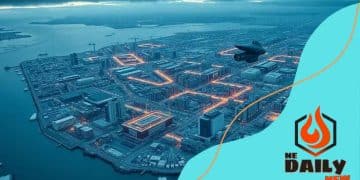The role of facial recognition in enhancing public safety

The role of facial recognition in enhancing public safety includes quickly identifying threats, improving security measures, and supporting law enforcement efforts in real-time surveillance and crime prevention.
The role of facial recognition in enhancing public safety has sparked considerable discussion. Have you ever wondered how this technology impacts your daily life and safety in public spaces? Let’s dive into it.
Understanding facial recognition technology
Understanding facial recognition technology is essential in today’s world. This technology uses algorithms to identify and verify individuals based on their facial features. It allows computers to recognize faces through image processing, transforming how we ensure security and safety.
Facial recognition works by capturing an image of a person’s face, analyzing distinctive features, and comparing them to a database. It’s used widely, from unlocking smartphones to identifying criminals in public spaces. The accuracy and speed of these systems are improving thanks to advancements in artificial intelligence and machine learning.
Key Components of Facial Recognition Technology
There are several important components that drive facial recognition systems:
- Image Capture: The first step involves capturing a clear image of the face, whether from a photo or a live feed.
- Feature Extraction: This process identifies unique facial features, such as the shape of the eyes, nose, and distance between them.
- Comparison Algorithm: The extracted features are then compared to a database of known faces.
This complex process involves advanced algorithms that make it possible to identify individuals with high accuracy. However, the implementation of this technology also raises questions regarding privacy and ethics.
Applications in Daily Life
Facial recognition is becoming increasingly common in various sectors:
- Law Enforcement: Police departments utilize this technology to identify suspects quickly.
- Retail: Stores use facial recognition for customer experience enhancement and security monitoring.
- Airports: Many airports employ this technology for quick check-ins and faster security processes.
While these applications enhance security and convenience, they also necessitate discussions about privacy regulations. Striking the right balance between safety and individual rights is crucial as this technology continues to evolve.
Benefits of facial recognition for public safety
The benefits of facial recognition for public safety are becoming increasingly evident as more organizations adopt this technology. It plays a crucial role in enhancing security measures across various sectors.
One significant advantage of facial recognition is its ability to quickly identify individuals in crowds. This technology can help law enforcement agencies during events or in busy public spaces, allowing for rapid responses to potential threats.
Enhanced Security Measures
Facial recognition systems bolster security measures in several ways:
- Real-time Monitoring: These systems can monitor live feeds and alert authorities if a known criminal is detected.
- Faster Investigations: By identifying suspects quickly, police can resolve cases faster, thereby enhancing community trust.
- Increased Deterrence: The presence of facial recognition technology can deter criminal activities, knowing that surveillance is in place.
This technology is also a valuable tool in managing large public gatherings, such as concerts, sports games, or festivals. By ensuring public safety in these crowded environments, authorities can maintain order and provide a secure experience for attendees.
Building Community Trust
Another benefit of facial recognition in public safety is its potential to build trust between communities and law enforcement. When used responsibly, it can lead to transparent operations where citizens feel more secure.
Moreover, integrating facial recognition technology with community policing initiatives can improve collaboration. Law enforcement can share information with citizens and offer reassurance regarding their safety.
Although there are valid concerns surrounding privacy and misuse, the positive impacts of facial recognition systems on public safety cannot be ignored. With proper regulations in place, this technology can significantly contribute to safer communities.
Privacy concerns involving facial recognition

Privacy concerns involving facial recognition are a hot topic today. As this technology becomes more mainstream, people are increasingly worried about how their personal information is being used.
The capability of facial recognition systems to identify individuals in real-time raises alarms about surveillance and data security. When cameras are placed in public spaces, many fear they are being watched constantly without their consent.
Data Collection and Usage
Understanding how data is collected and used is crucial. There are several key points to consider:
- User Consent: In many cases, people may not know that their faces are being scanned and stored.
- Data Security: How secure is the information collected? If data breaches occur, it can lead to misuses of private information.
- Tracking Capabilities: Facial recognition can track movements across different locations, raising concerns about being monitored at all times.
A common worry is whether this data could be accessed by third parties or misused by authorities. For instance, if law enforcement agencies use this technology, it opens the floor to questions about racial profiling and discrimination. Communities may feel targeted or unfairly treated based on biased algorithms.
Legal and Ethical Implications
Privacy concerns also lead to discussions about legal frameworks. Many regions are still trying to catch up with regulations that govern the use of facial recognition. Laws need to balance safety and personal privacy. Transparent policies are necessary to ensure that people feel safe and respected while using public spaces.
Ethically, companies and governments using this technology should actively consider its impact on society. Public discussions involving citizens can help in shaping how facial recognition is implemented responsibly, ensuring it serves the community rather than infringing on personal freedoms.
Real-world applications improving public safety
Real-world applications of facial recognition technology are transforming public safety measures. This technology plays a critical role in various sectors, helping to ensure security in our communities.
One prominent application is in law enforcement. Police departments around the world utilize facial recognition to identify suspects quickly during investigations. This capability significantly speeds up the process of solving crimes, leading to safer neighborhoods.
Enhancing Security in Public Spaces
Another key area is enhancing security in crowded venues, such as stadiums and airports. Facial recognition systems can:
- Monitor Large Crowds: By observing the movements of individuals, security can identify potential threats in real time.
- Assist in Screening: During events, attendees can be screened quickly to ensure they are not on a watch list.
- Improve Emergency Responses: In case of an incident, security teams can react swiftly by identifying individuals linked to harmful activities.
These benefits make events safer for everyone involved, allowing attendees to enjoy themselves without fear.
Integration in Smart Cities
As cities become smarter, facial recognition technology is being integrated into urban infrastructure. For example, traffic systems can manage traffic flow by recognizing license plates in real-time. This can help reduce congestion and improve emergency vehicle response times.
Moreover, public transportation systems can enhance passenger security through surveillance. By implementing facial recognition on buses and trains, authorities can monitor for suspicious activity and ensure the safety of commuters.
The impact of facial recognition technology extends beyond just immediate security; it creates a safer environment for people to live and work. As technology continues to advance, its applications in public safety will only grow, proving essential in modern society.
Future trends in facial recognition systems
Future trends in facial recognition systems are set to reshape how this technology is used, creating even more sophisticated applications. As advancements in artificial intelligence and machine learning continue, we can expect to see significant improvements in accuracy and efficiency.
One notable trend is the increasing integration of facial recognition with other technologies. For example, combining facial recognition with artificial intelligence can enhance security measures by automatically detecting suspicious behavior in real-time. This integration can result in smarter surveillance systems that not only identify faces but also assess actions and intentions.
Improved Accuracy and Speed
Technology is evolving rapidly, leading to enhanced accuracy rates. New algorithms enable systems to correctly identify individuals, even in challenging environments. Factors like lighting, angle, and crowd density no longer pose significant challenges. Additionally, processes are becoming faster, allowing for immediate identification during live video feeds.
As facial recognition becomes more common, there is a strong focus on reducing biases that may arise in identification. Developers are working on systems that are equally effective across diverse demographics. By training algorithms on a wide range of data sets, the likelihood of misidentification decreases dramatically.
Greater Adoption Across Sectors
More industries are adopting facial recognition technology to enhance their operations. For instance, the retail sector is leveraging it to improve customer experiences. Stores can analyze foot traffic and personalize marketing efforts based on customer profiles.
Healthcare facilities are also finding innovative uses for this technology. By implementing facial recognition for patient identification, hospitals can improve both security and efficiency. This could lead to faster access to medical records and improved patient care.
As laws and regulations evolve, ethical considerations surrounding facial recognition will remain a significant focus. There will be ongoing discussions about privacy and the balance between security and personal freedoms. Overall, the future holds promising developments that will shape the landscape of facial recognition systems.
FAQ – Frequently Asked Questions about Facial Recognition in Public Safety
What are the main benefits of facial recognition technology?
Facial recognition technology enhances public safety by quickly identifying threats, improving security measures, and aiding law enforcement in investigations.
How does facial recognition impact personal privacy?
Facial recognition raises privacy concerns as it involves constant monitoring and data collection without consent, leading to potential misuse of personal information.
What future trends can we expect in facial recognition systems?
Future trends include improved accuracy and speed of identification, integration with AI for smarter surveillance, and broader adoption across various industries.
How can communities address the ethical implications of facial recognition?
Communities can engage in discussions about regulations and ethical practices to ensure facial recognition systems are used responsibly and with respect for individual rights.





